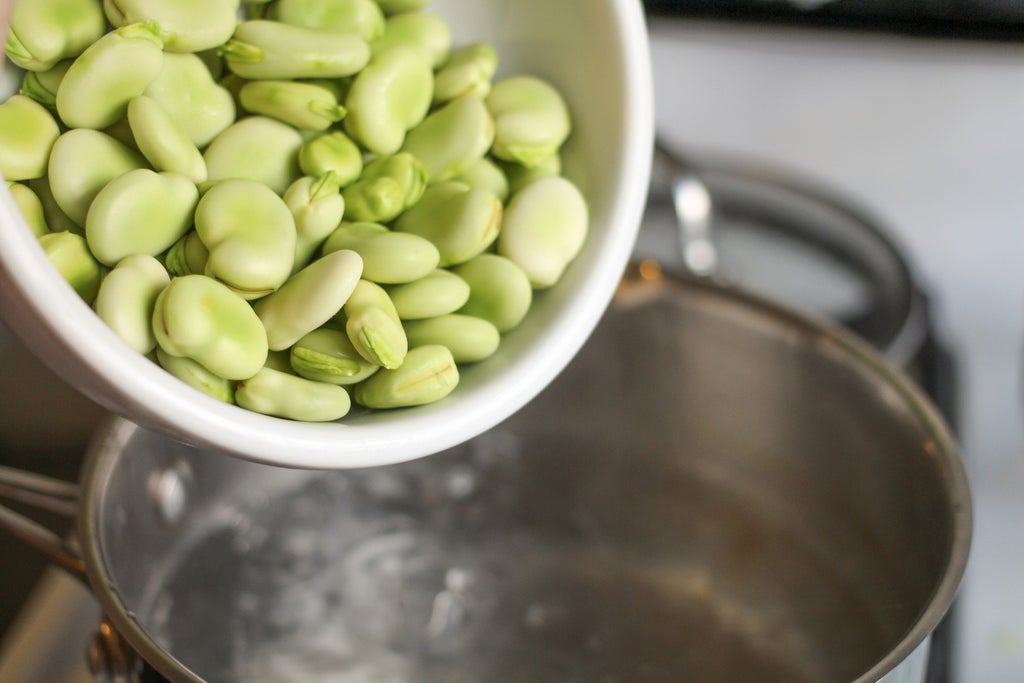Introduction: Boiling, Simmering and Stewing
In this lesson, we'll cover boiling, simmering and stewing! I'm grouping these cooking techniques together because each involves cooking in liquid. Boiling is typically a quick process, while simmering and stewing tend to take a longer amount of time.
Keep in mind that simmering and stewing are often secondary cooking techniques used after sautéing or pan frying.
Boiling is also very important when it comes to canning food, so if you're interested in that be sure to check out Paige Russell'sCanning and Preserving Class!
Step 1: What Is Boiling?

Photo above: cooking fava beans in boiling water
Boiling is just what it sounds like: bringing a liquid up to a boil over high heat and cooking with it! It's not commonly the main cooking technique used in a recipe, but instead just one part of the process.
In many recipes, you'll bring liquid to a boil and then down to a simmer. Or you may boil vegetables (often called "blanching"), only to "shock" them in ice water after to stop their cooking and keep their bright color.
Boiling is most often used to cook eggs, vegetables, and pasta. Boiling water and vinegar can also be used to make quick pickles, which are a nice accompaniment to dinner - I make them quite a lot! (I've included a few quick pickle recipes in the collection below!)
Depending on the recipe you're making, you may want to add the food to cold water and bring it to a boil, or you may want to add the food to boiling water. Pay attention to the recipe to know which way is right - this can make a huge difference in the end result!
Step 2: Boiling Recipes

I've made a collection of recipes where boiling is the main cooking technique used!
I've only included one noodle based dish here. If you'd like to see more, you should check out Paige Russell'sPasta Class for an in depth look at pasta. :D
Step 3: What Are Simmering and Stewing?

Photo above: a quick simmer during my black bean chili recipe
Simmering
Simmering is essentially cooking in liquid over low heat.
While a full rolling boil has large bubbles coming to the surface constantly, a simmer is when the liquid has small, occasional bubbles breaching the surface. This way of cooking is very gentle, so it's a great way to cook tough meats, beans and root vegetables.
Simmering is the primary technique used when poaching foods such as chicken or fish. It's also useful when you need to skim fat, proteins, or other substances from the top of a sauce, soup, stock or stew. (For an example of what I tend to skim, check the second photo here from my beef stew recipe.)
The amount and type of liquid will vary widely from recipe to recipe. Some recipes, like soups, will require much more liquid at the start. Recipes such as chilis and sauces use less liquid and are often "reduced" at the end of cooking by uncovering the pot and letting some liquid evaporate.
Stewing
Stewing is simmering something for a long amount of time which results in a thickened finished product. Stews can be thickened even more in a variety of ways, like by adding flour, cornstarch, or by flouring and browning the meat used in the stew.
It's a very slow cooking process that is almost always done when the pot is covered. This allows you to start a stew on the stovetop and move it to the oven to finish cooking. (Bring to a boil on the stovetop, and then transfer the covered pot to an oven set to 300-325 F / 150-175 C.)
Stewing often starts with browning your meat of choice and then sautéing any aromatics and vegetables in the same pan. The liquid released from the aromatics and vegetables allows you to scrape up all the browned bits left from the meat, which adds great depth of flavor. Once that's done, you add your liquid of choice and let it stew away.
This process is very similar to braising and you may sometimes hear it referred to that way. The only real differences in these two techniques is that when braising, you use VERY little liquid and tend to keep the meat in one piece.
Step 4: Simmering and Stewing Recipes

Now that you understand the basics of simmering and stewing, why not try out a few recipes?
Simmering and Stewing Recipes Collection
To wrap up this cooking class, we'll move on to baking, broiling and roasting.
Step 5: Lesson Quiz
{
"id": "quiz-1",
"question": "Which cooking technique is most similar to braising?",
"answers": [
{
"title": "Simmering",
"correct": false
},
{
"title": "Stewing",
"correct": true
},
{
"title": "Boiling",
"correct": false
}
],
"correctNotice": "That's correct!",
"incorrectNotice": "That is incorrect."
}
{
"id": "quiz-2",
"question": "What is an ingredient that is often cooked by boiling?",
"answers": [
{
"title": "Meat",
"correct": false
},
{
"title": "Dairy",
"correct": false
},
{
"title": "Eggs",
"correct": true
}
],
"correctNotice": "That's correct!",
"incorrectNotice": "That is incorrect."
}
{
"id": "quiz-3",
"question": "What does it mean to reduce a liquid?",
"answers": [
{
"title": "Thickening the liquid with cornstarch",
"correct": false
},
{
"title": "Allowing a liquid to cook uncovered and evaporate",
"correct": true
},
{
"title": "Removing some liquid from the pan",
"correct": false
}
],
"correctNotice": "That's correct!",
"incorrectNotice": "That is incorrect."
}













